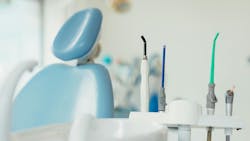Equipment in your dental practice may not be the first thing patients notice, but it plays an important role in how well you serve them. When something breaks down, whether it's a sterilization unit, a dental chair, or an imaging machine, it can lead to expenses that extend the obvious repair bills. You face unplanned downtime, delayed procedures, and even damage your reputation.
In short, equipment failure disrupts your day-to-day routine and can seriously strain your business. According to reports, dental clinics spend an average of 7.2% of their overhead on equipment each year. Reducing this cost can help improve your profit margins and give you more freedom to invest in improving patient care and expanding your practice.
The impact of equipment failure
Your goal is to deliver excellent patient experiences, but this becomes a challenge when important equipment stops working. Treatment plans get delayed and patients lose confidence. Understanding these consequences is the first step to preventing these problems.
1. Financial costs
Repair bills can grow fast. You don't just pay for parts and labor; you also lose revenue when you reschedule or turn patients away. In some cases, you might even need to rent or purchase temporary replacements, compounding your costs.
It's standard for dental practices to keep a budget for routine expenses, but equipment failure can throw your entire financial plan off course. You might have to dip into emergency funds or defer to other important investments. According to industry reports, unplanned repairs can exceed five to seven times the cost of scheduled preventive work.2 Even if the repair seems minor, the effect of canceled appointments can escalate quickly and hurt your annual income.
2. Compromised patient care
When a sterilization unit breaks down, you might need to delay certain procedures or refer patients elsewhere. Disruptions like this can decrease patient satisfaction.3 In the worst-case scenario, a broken piece of equipment could affect the safety and comfort of your patient. This may result in long-lasting negative impressions.
3. Bad business reputation
Trust is important for any dental practice. If patients hear the drill die out midprocedure or experience rescheduling multiple times because your equipment isn't well- maintained, they might start to question your professionalism. It's easy for a negative experience to spread through word-of-mouth or online reviews.
Studies show that people are more likely to share bad experiences online than good ones, and a single piece of negative feedback can cause prospective patients to reconsider booking an appointment with you.4 Even if you resolve the issue, doubts can remain, which will put your long-term growth at risk.
4. Increased stress among the team
When equipment breaks, your team will likely be more frustrated, stressed, and discouraged. They will try to find quick fixes, work around delays, and reschedule patients-and when your team is under pressure, it shows. Patient interactions may become rushed or lack the warmth you want to provide. Overworked staff members are also more prone to mistakes, which can create more challenges.
Strategies to guarantee equipment reliability
You can't avoid equipment failures entirely, but you can plan ahead to reduce the risk of breakdowns. Here are the best ways to avoid equipment damage.
Choose quality equipment
Cutting costs with cheaper equipment models might be tempting, but those immediate savings can lead to larger expenses in the future. Higher-quality equipment often offers more dependable performance and better warranty options. When you invest in durable equipment from reputable manufacturers, you minimize the chances of random failures.
Quality equipment also has a longer lifespan, which gives you more time before you need to consider an upgrade or replacement. This gives you peace of mind knowing that the tools you rely on most will likely deliver consistent results in the long run.
Develop a preventive maintenance program
You can avoid stressful downtime if you schedule regular checkups for your equipment. Think of it as taking your car for an oil change; small efforts now save you from bigger repairs later. For instance, preventive maintenance of medical technology may involve routine sterilizer checks or yearly calibration for imaging systems. These measures help catch issues before they become big problems.
Rather than waiting for something to break, plan ahead and set up a monthly or quarterly schedule. Your team will appreciate a predictable routine, and you'll feel confident to know that your equipment is in the best condition.
Train staff on equipment use and care
Even the best equipment can fail early if it's handled improperly. Make sure every member of your team understands basic operating procedures. Clear and consistent training can reduce mistakes that lead to failures. This can include showing staff how to run daily checks, follow proper cleaning steps, and report any unusual noises or performance issues right away. Training also helps staff identify smaller problems before they escalate. For example, if a team member notices a slight issue, they can alert you early, allowing you to arrange a quick inspection instead of a major repair.
Have a plan in case equipment fails
No matter how careful you are, technology can still surprise you. This is why a backup plan guarantees that an unexpected breakdown doesn't make you panic. Keep a list of local technicians you trust and establish relationships with rental providers for important equipment. This way, you have immediate options if something goes wrong.
Pro tip: Train your staff beforehand on what to do in case of an unexpected breakdown. A step-by-step protocol saves time, reduces stress, and protects the patient experience.
Conclusion
Equipment failure in dentistry affects more than just your repair budget. While these failures can strike without warning, you have the power to lessen their impact through smart choices and preventive measures.
Instead of going for the lowest price, invest in reliable equipment. Set up a proactive maintenance plan and make sure your team knows how to operate and care for the devices they use every day. Prepare a backup strategy for worst-case scenarios. These steps can help you avoid the high costs associated with downtime and keep your practice on track.
When you take charge of your equipment's reliability, you're looking out for your patient's best interests. This helps you build trust and loyalty-by addressing the hidden dangers of equipment failure, you'll make sure that everyone involved, from patients to staff, benefits from a positive dental care experience.
References
-
waiting on source
-
11 disadvantages of a reactive maintenance program. Prometheus Group. https://www.prometheusgroup.com/resources/posts/11-disadvantages-of-a-reactive-maintenance-program
-
Levin R. The patient experience matters most. Dental Economics. October 9, 2019. https://www.dentaleconomics.com/practice/article/14068347/the-patient-experience-matters-most
-
Customer service and business results: A survey of customer service from mid-size companies. Dimensional Research. April 2013. http://cdn.zendesk.com/resources/whitepapers/Zendesk_WP_Customer_Service_and_Business_Results.pdf
About the Author

Maggie Nelson
Maggie Nelson is an experienced HR manager and a passionate freelance writer with ongoing curiosity to learn new things. She is deeply convinced that valuable experience sharing is key to business success. Maggie believes in a win-win formula and utilizes it on a daily basis in staff management.
